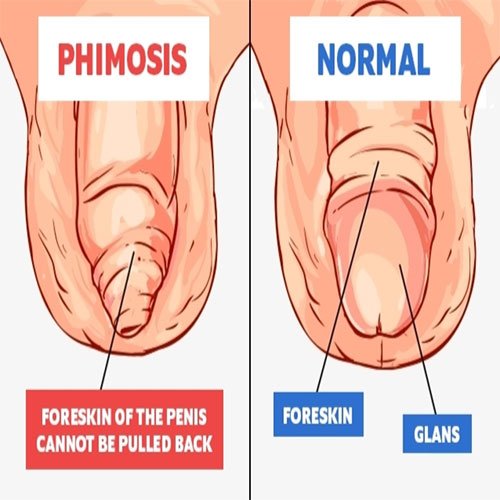
Phimosis
Phimosis
Phimosis is a condition characterized by the inability to retract the foreskin (prepuce) over the glans (tip) of the penis. This condition is common in infants and young boys, as their foreskin is often adherent to the glans at birth. In many cases, the foreskin will gradually become retractable as the child grows older. However, phimosis can also occur in older children and adults, leading to discomfort, pain, or complications.
Phimosis is a common condition that often resolves naturally in childhood. If it persists or causes discomfort, various treatment options are available. It’s important to consult with a healthcare provider for a proper diagnosis and to discuss the most appropriate treatment plan based on individual circumstances. Early intervention can prevent complications and improve quality of life.

Types of Phimosis
Physiological Phimosis: This is the normal condition in infants and young boys, where the foreskin is not retractable due to natural adhesion between the glans and foreskin. Most boys outgrow this condition without treatment.
Pathological Phimosis: This occurs when the foreskin becomes non-retractable due to scarring, inflammation, or infection. Conditions such as balanitis (inflammation of the glans) or repeated infections can contribute to pathological phimosis.
Symptoms
- Inability to retract the foreskin
- Pain during erections
- Swelling or redness of the foreskin or glans
- Difficulty urinating or painful urination
- Recurrent urinary tract infections (UTIs)
- In severe cases, paraphimosis can occur, where the retracted foreskin cannot return to its original position, leading to swelling and pain.
Diagnosis
Phimosis is typically diagnosed through a physical examination by a healthcare provider. The doctor will assess the degree of retraction of the foreskin and check for any signs of infection or scarring.
Treatment Options
The treatment for phimosis depends on the severity of the condition and whether it is causing symptoms:
Conservative Management:
- Topical Steroid Creams: Applying a topical steroid cream can help soften the foreskin and allow for easier retraction. This is often recommended for mild cases.
- Gentle Stretching: Gradual stretching of the foreskin can help in some cases. This should be done with caution and under the guidance of a healthcare professional.
Medical Interventions:
- Circumcision: In cases of severe phimosis or recurrent infections, circumcision (surgical removal of the foreskin) may be recommended. This is a definitive treatment and eliminates the problem entirely.
- Preputioplasty: This is a less invasive surgical option that involves widening the opening of the foreskin without complete removal. It may be suitable for some patients.
Management of Underlying Conditions: If phimosis is due to an underlying infection or skin condition, appropriate treatment for these issues will be necessary.
